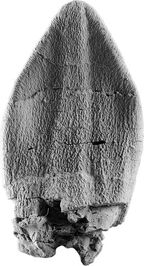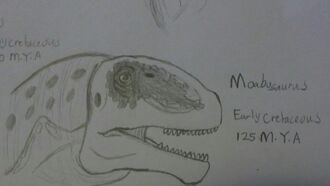Tag: Visual edit |
(Adding categories) |
||
| (3 intermediate revisions by one other user not shown) | |||
| Line 1: | Line 1: | ||
| − | {{Taxobox/core|name = Moabosaurus|regnum = [[Animal]]ia|image = 20170622 192837.png|thumb|400 px|image_caption = Reconstructed skeleton of Moabosaurus utahensis|classis = [[Reptilia]]|superordo = [[Dinosauria]]|ordo = [[Saurischia]]|subordo = [[Sauropodamorpha]]|clade1 = [[Neosauropoda]]|clade 2 = [[Macronaria]]|clade 3 = [[Turiasauria]]|clade = [[Turiasauria]]| genus = Moabosaurus|genus_authority = Brit et,. al, 2017|type_species = Moabosaurus utahensis|type_species_authority = Britt et., al}}'''''Moabosaurus''''' (meaning "Moab reptile") is a genus of titanosauriform sauropod dinosaur from the Early Cretaceous Cedar Mountain Formation of Utah, United States. |
+ | {{Taxobox/core|name = Moabosaurus|regnum = [[Animal]]ia|image = 20170622 192837.png|thumb|400 px|image_caption = Reconstructed skeleton of a juvenile Moabosaurus utahensis|classis = [[Reptilia]]|superordo = [[Dinosauria]]|ordo = [[Saurischia]]|subordo = [[Sauropodamorpha]]|clade1 = [[Neosauropoda]]|clade 2 = [[Macronaria]]|clade 3 = [[Turiasauria]]|clade = [[Turiasauria]]| genus = Moabosaurus|genus_authority = Brit et,. al, 2017|type_species = Moabosaurus utahensis|type_species_authority = Britt et., al}}'''''Moabosaurus''''' (meaning "Moab reptile") is a genus of titanosauriform sauropod dinosaur from the Early Cretaceous Cedar Mountain Formation of Utah, United States. |
[[File:Moabosaurus_Tooth_in_Lingual_View.tif.jpg|thumb|144px|Moabosaurus tooth iin lingual view. Unlike in earlier turiasaurs, Moabosaurus developed a robust set of teeth, more spatulate in shape much similar to unrelated Camarasaurus.]] |
[[File:Moabosaurus_Tooth_in_Lingual_View.tif.jpg|thumb|144px|Moabosaurus tooth iin lingual view. Unlike in earlier turiasaurs, Moabosaurus developed a robust set of teeth, more spatulate in shape much similar to unrelated Camarasaurus.]] |
||
| Line 9: | Line 9: | ||
==Paleoecology== |
==Paleoecology== |
||
| − | The Dalton Wells quarry has also yielded specimens of ''[[Venenosaurus]]'' (a brachiosaurid sauropod), the theropod dinosaurs ''[[Utahraptor]]'' and ''[[Nedcolbertia]]'', plus a tall-spined [[iguanodontia]]n, and the ankylosaurian ''[[Gastonia (dinosaur)|Gastonia]]''. Non-dinosaurian taxa are rare at the quarry and are limited to fragments of a [[pterosaur]], [[crocodilia]]n, [[turtle]], and a [[Neochoristodera|neochoristodere]] (a crocodile-like reptile). In the Aptian (125 Ma), the biome environment of Dalton Wells quarry was arid, specifically something similar to a semidesert. Temperature climates were likely hot, and humid as at this time, the state Utah was |
+ | The Dalton Wells quarry has also yielded specimens of ''[[Venenosaurus]]'' (a brachiosaurid sauropod), the theropod dinosaurs ''[[Utahraptor]]'' and ''[[Nedcolbertia]]'', plus a tall-spined [[iguanodontia]]n, and the ankylosaurian ''[[Gastonia (dinosaur)|Gastonia]]''. Non-dinosaurian taxa are rare at the quarry and are limited to fragments of a [[pterosaur]], [[crocodilia]]n, [[turtle]], and a [[Neochoristodera|neochoristodere]] (a crocodile-like reptile). In the Aptian (125 Ma), the biome environment of Dalton Wells quarry was arid, specifically something similar to a semidesert or steppe environment. Temperature climates were likely hot, and humid as at this time, the state Utah was enriched with large bodies of water. In similarity to most environments akin from the Late Jurassic, dinosaurs such ''Moabosaurus ''adapted a similar niche, filling in the role of the previous Camarasaurus. |
==Diet == |
==Diet == |
||
| Line 19: | Line 19: | ||
[[Category:Cretaceous dinosaurs]] |
[[Category:Cretaceous dinosaurs]] |
||
[[Category:Late Cretaceous Dinosaurs]] |
[[Category:Late Cretaceous Dinosaurs]] |
||
| + | [[Category:Turiasauria]] |
||
| + | [[Category:Sauropods]] |
||
| + | [[Category:Dinosaurs]] |
||
| + | [[Category:Dinosaurs of Utah]] |
||
| + | [[Category:Prehistoric animals of North America]] |
||
Revision as of 16:31, 13 March 2020
| Moabosaurus | |
|---|---|

| |
| Reconstructed skeleton of a juvenile Moabosaurus utahensis | |
| Scientific classification | |
| Kingdom: | Animalia |
| Class: | Reptilia |
| clade: | Neosauropoda |
| Superorder: | Dinosauria |
| Order: | Saurischia |
| Suborder: | Sauropodamorpha |
| Genus: | Moabosaurus Brit et,. al, 2017 |
| Type species | |
| Moabosaurus utahensis Britt et., al | |
Moabosaurus (meaning "Moab reptile") is a genus of titanosauriform sauropod dinosaur from the Early Cretaceous Cedar Mountain Formation of Utah, United States.

Moabosaurus tooth iin lingual view. Unlike in earlier turiasaurs, Moabosaurus developed a robust set of teeth, more spatulate in shape much similar to unrelated Camarasaurus.
Description
Moabosaurus is characterized by a suite of features including: extremely low neural spines that are thin, transverse ridges in the posterior cervical vertebrae and anterior dorsal vertebrae; strongly procoelous proximal and distal caudal vertebrae; and an ulna with well-developed lateral and medial anteroproximal ridges combined with a large olecranon process. According to paleontologist, Brooks Britts, the braincase of this sauropod held a very small brain, in comparable size to a Chinese eggroll. As an estimate the overall length of Moabosaurus suggests it was around 12m (40ft). The front limbs of the dinosaur very short in contrast to much larger sauropods with exception of Camarasauridae and Brachiosauridae groups.
Discovery and naming
Moabosaurus was collected from the Dalton Wells Quarry, which is about 20 km northwest of Moab, Utah. The quarry produced parts of at least 18 individuals of Moabosaurus based on the number of braincases present, totalling over 5,500 bones. Many of the recovered bones are fragmentary due to intense trampling as evidenced by breakage and trample scratches. Another factor that degraded the bones before burial was consumption by insects. Insects, probably beetle larvae, consumed portions of the bones that were in contact with the ground, as evidenced by burrows and mandible marks. Later, the bones were transported a short distance by a stream and buried in sediments reworked from the underlying Morrison Formation. Detrital zircon crystals from the Dalton Wells Quarry yield an age of 125 million years, indicating Moabosaurus is Aptian in age.
Paleoecology
The Dalton Wells quarry has also yielded specimens of Venenosaurus (a brachiosaurid sauropod), the theropod dinosaurs Utahraptor and Nedcolbertia, plus a tall-spined iguanodontian, and the ankylosaurian Gastonia. Non-dinosaurian taxa are rare at the quarry and are limited to fragments of a pterosaur, crocodilian, turtle, and a neochoristodere (a crocodile-like reptile). In the Aptian (125 Ma), the biome environment of Dalton Wells quarry was arid, specifically something similar to a semidesert or steppe environment. Temperature climates were likely hot, and humid as at this time, the state Utah was enriched with large bodies of water. In similarity to most environments akin from the Late Jurassic, dinosaurs such Moabosaurus adapted a similar niche, filling in the role of the previous Camarasaurus.
Diet
Among the 5,500 bones numerous teeth from Moabosaurus were pulled from the Dalton Wells quarry. Unlike in most turiasaurs, which were known for their heart-shaped teeth, the tooth crowns were spatulate-like resembling that of a spoon or shovel. Based on the evidence, this indicated Moabosaurus were suited for high-browsing life-style, consuming the confifers that flourished the arid ecosystem.

An illustration of Moabosaurus, depicting skull elements of the closer Mierasaurus and lesser Camarasaurus.